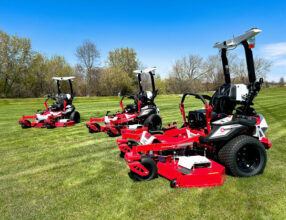Squeezing the profits out of your inventories
By Bob Clements
When it comes to running a profitable outdoor power equipment dealership, few things have more impact on the amount of money you actually take home than the levels of inventory you carry through your season.
For most OPE dealers, when you talk to them about inventory, their minds immediately move to the amount of wholegoods they are carrying on hand or on floor plan at any given time during their year. While wholegoods inventory is important to monitor and maintain, you must also consider your parts, pre-owned equipment and labor inventories as you move through the 2008 selling season.
Wholegoods inventory
As you think about your inventories, the first question you should always ask yourself is NOT how much do I need, but how quickly can I get it replenished if I run low. With wholegoods, it will vary greatly by manufacturer. Your goal is to keep the absolute lowest inventory you can while taking advantage of any discounts for early bookings and free shipping.
One simple way to lower your wholegoods inventories is to limit the number of manufacturers you carry. I am an advocate of carrying maybe two manufacturers that complement each other with ride-on equipment — “Zs” and tractors — and limiting yourself to one manufacturer on the handheld and walk-behinds. I know that most dealers carry multiple ride-on lines and two, three or even four handheld and walk-behind lines. But in doing so, you have automatically increased your inventory levels, strained your floor-plan dollars, complicated your selling process, added to your parts inventory, and reduced the overall profitability of your service department by having to manage multiple warranty programs while attending multiple service schools.
By reducing your manufacturers to two or three, you also reduce the number of programs to understand and track, the number of finance programs to deal with, the number of co-op advertising programs to think about, and the number of times you are interrupted during the season by salespeople expecting a little of your time because you handle their lines. Most importantly, you reduce the amount of time it takes to complete a sale to a customer during your busiest time of the year. When customers walk into most dealerships today, they are overwhelmed with the choices they have in front of them. Keep in mind when you give people two or three options, they are going to ask you to spend a little bit of time explaining each one of them. If you spend a total of 30 minutes with a customer explaining three different manufacturers’ equipment, you could reduce your selling time by one-third if you eliminated the weakest of the three lines from your inventory.
In an eight-hour day, you would add over 2.5 hours of selling time to your day, nearly 13 hours for the week and over 52 hours for the month. By eliminating one line, you have not only reduced your wholegoods inventory, but over a four-month period, you have added 26 selling days to your season. If you average selling just two pieces of equipment per day during season, you have increased your sales by 52 units. If those units are ride-on, and on the low side, you net $500 per unit and improve your bottom-line pre-tax dollars by $26,000. And who said there is no money in the outdoor power equipment business?
Pre-owned equipment inventory
While we are talking about wholegoods, let’s spend just a moment on those dealers who take trade-ins. If you are one of the dealers that works with my organization, you already know what I am going to say: Don’t take trade-ins! They kill your cash flow and create a lawsuit liability that I personally wouldn’t want to have. If you have pre-owned equipment, then do what you have to do to get your cash out of it and make this year the year you reduce it to “zero.”
I can hear the moans now. You’re saying, “But you don’t understand, Bob. We have to take trade-ins. The customers demand it, and besides, we make good money on them.” And to you, I will say, “No, you don’t.” First of all, trade-ins consume your cash. If you sell a new piece of equipment for $6,000, which you have floor planned for $5,000, and take a trade-in for $1,500, you instantly lost $1,500 of cash flow. Then, there’s the liability you have to consider. If a person who buys a used piece of equipment from you is hurt because of something the previous owner did to modify the equipment such as disabling a safety switch or rebuilding the deck, you are going to be the one that customer comes back to with a lawsuit. Hey, if a woman can get a couple of million dollars from a fast-food restaurant for hot coffee in her lap, the loss of a foot, hand or eye is going to be worth more than that from you.
Rather than take a trade-in, I have my dealers put customers’ equipment on consignment for 45 days and charge the customer 20 to 30 percent to sell it. If it is not sold in 45 days, my dealers call their customers and ask them what they would like to do with the equipment. In most cases, the customers tell the dealer to keep it — they don’t want to mess with it. Now, you have the equipment, can spend the money to bring it up to where it is safe and sellable, and sell it. Again, stay away from trade-ins, and keep your cash flow and your business healthy.
Parts inventory
Parts inventory should be one of the simplest areas to manage. But, like golf, simple doesn’t mean easy.
For starters, most dealers have way too many parts on hand. Years ago, when transportation wasn’t what it is today and manufacturers were not as efficient, it might take 30 days to get the parts you need to do repairs. As a result, dealers had to carry an inventory level that would ensure them they would have what they needed to fix equipment that would be coming in during season. Many dealers back then prided themselves on having all the parts the customers could ever need. While that was a noble cause 10 or 20 years ago, things have changed.
Today, you have original equipment manufacturers and aftermarket suppliers that have over a 90-percent fill rate in 24 hours. If I am a parts manager and can get over 90 percent of my parts in 24 hours, I don’t want to carry anymore than I absolutely have to. The rule of thumb for our dealers is to carry no more than a two-week supply of your fastest- moving parts on hand at any one time. To find your fastest-moving parts during season, go to your software and run a report of parts sales during season last year. Look at the top 50, 100 or 200 parts, and make sure you have what you need to meet a two-week demand. If you have a specific oil filter that you sell a case of 50 per week, you don’t need 10 cases on hand taking up valuable room in your parts department. I know you have opportunities to take advantage of early order specials and free shipping. Only order what you need to get the best rates, and then stay on top of your inventory on a daily basis to fill in.
Your ultimate goal for your parts inventory is to manage it down to where it is no larger than 20 percent of your projected parts sales for the season. If during season last year you did $400,000 in parts sales, we would like to see you have no more than $80,000 in inventory during the peak of your season and then bleed it down to $40,000 by the end of the year.
Labor inventory
Your labor inventory is the last element in the dealership you have to stay focused on during the year. Over the course of a year, each service tech that you employ has 2,000 billable hours of time inventory. At $65 per billable hour, that is a total of $130,000 they are responsible for producing. If you have a service manager, that person needs to be held accountable for those hours of inventory, just as parts managers and wholegoods managers are responsible for accounting for their inventories.
Don’t accept that it can’t be done. I have had the pleasure of working with too many dealers that had given up on their service department to find, with a little help and guidance, that it can be the most profitable part of the dealership. Ralph Helm III and his partner Jim Brandes of Ralph Helm, Inc. in Elgin and Crystal Lake, Ill., completely turned around their service department. By changing their compensation programs using menu pricing and having a service manager who holds people accountable, they are selling an average of 93 percent of their time inventory or a total of over 1,800 hours per tech per year (and they charge a lot more than $65 per hour). The partnership of Helm and Brandes is a great example of what you can do when you decide to become the number one owner instead of the number one employee for your dealership.
Make 2008 the year that you decide to work on your business, seize control of all your inventories, and watch your profits soar.
Bob Clements is the president of Bob Clements International, a consulting firm that specializes in the development of high-performance dealerships. His organization works hands on with dealerships throughout North America, helping them attain the personal freedom and financial wealth all entrepreneurs strive to achieve. For more information, contact Bob Clements at (800) 480-0737 or bob@bobclements.com or visit his Web site at www.bobclements.com.



